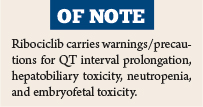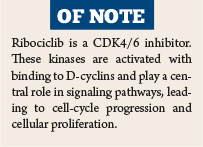In the Clinic provides overviews of novel oncology agents, addressing indications, mechanisms, administration recommendations, safety profiles, and other essential information needed for the appropriate clinical use of these drugs.
On March 13, the cyclin-dependent kinase (CDK) 4/6 inhibitor ribociclib (Kisqali) was approved for use in combination with an aromatase inhibitor as initial endocrine-based therapy for the treatment of postmenopausal women with hormone receptor–positive, HER2-negative advanced or metastatic breast cancer.1,2
Supporting Efficacy Data
Approval was based on improved progression-free survival with ribociclib plus letrozole vs letrozole in a double-blind, placebo-controlled phase III trial (MONALEESA-2).2,3 A total of 668 women who had received no prior therapy for advanced disease were randomized to receive ribociclib plus letrozole (n = 334) or placebo plus letrozole (n = 334). Ribociclib at 600 mg or placebo was given once daily for 21 consecutive days, followed by 7 days off in each 28-day cycle; letrozole was given at 2.5 mg once daily for 28 days in each cycle. Treatment continued until disease progression or unacceptable toxicity.

Patients had a median age of 62 years (45% > 65 years); 82% were white; all patients had an Eastern Cooperative Oncology Group performance status of 0 or 1; 47% received chemotherapy and 51%, hormonal therapy in the neoadjuvant or adjuvant setting; 34% had de novo metastatic disease, 21% had bone-only disease, and 59% had visceral disease.
A preplanned interim analysis showed significantly improved investigator-assessed progression-free survival with ribociclib plus letrozole (hazard ratio = 0.556, P < .0001). Median progression-free survival was not reached (95% confidence interval [CI] = 19.3 months to not reached) vs 14.7 months (95% CI = 13.0–16.5 months). Objective response rates in patients with measurable disease were 52.7% vs 37.1%, respectively.
How It Works
Ribociclib is a CDK4/6 inhibitor. These kinases are activated with binding to D-cyclins and play a central role in signaling pathways, leading to cell-cycle progression and cellular proliferation. The cyclin D–CDK4/6 complex regulates cell-cycle progression through phosphorylation of the retinoblastoma protein.
In studies in vitro, ribociclib decreased phosphorylation of the retinoblastoma protein, leading to arrest in the G1 phase of the cell cycle and reduced cell proliferation in breast cancer cell lines. Ribociclib treatment in a rat xenograft model led to a decreased tumor volume, which was correlated with inhibition of phosphorylation of the retinoblastoma protein. In studies in patient-derived estrogen receptor–positive breast cancer xenograft models, the combination of ribociclib and an antiestrogen agent (eg, letrozole) resulted in greater tumor growth inhibition than each drug alone.
How It Is Used
The recommended dose of ribociclib is 600 mg once daily for 21 consecutive days, followed by 7 days off treatment in each 28-day cycle. Co-administered letrozole is given at 2.5 mg once daily throughout the 28-day cycle. The recommended starting dose of ribociclib is 400 mg for patients with moderate or severe hepatic impairment.
Approval of Ribociclib in Advanced Breast Cancer
- Ribociclib (Kisqali) was approved for use in combination with an aromatase inhibitor as initial endocrine-based therapy for the treatment of postmenopausal women with hormone receptor–positive, HER2-negative advanced or metastatic breast cancer.
- The recommended dose of ribociclib is 600 mg once daily for 21 consecutive days, followed by 7 days off treatment in each 28-day cycle. Co-administered letrozole is given at 2.5 mg once daily throughout the 28-day cycle.
Dose modification for adverse events is to 400 mg daily and then to 200 mg daily, with treatment being discontinued if further dose reduction is required. Specific dose modifications are recommended for neutropenia, hepatobiliary toxicity, and QT prolongation.
For grade 3 neutropenia, treatment should be interrupted until recovery to grade ≤ 2 and resumed at the same dose; for recurrence, treatment should be started at the next lower dose level after recovery. For grade 3 febrile neutropenia or grade 4 neutropenia, treatment should be interrupted until recovery to grade ≤ 2 and then resumed at the next lower dose.
For elevations in alanine transaminase (ALT) or aspartate transaminase (AST) without elevation in total bilirubin to > two times the upper limit of normal, treatment should be interrupted for grade 2 or grade 3 toxicity until recovery to ≤ baseline grade and resumed at the same dose for grade 2 toxicity and at the next lower dose for grade 3 toxicity; the dose should be lowered for recurrence of grade 2 toxicity, and treatment should be discontinued for recurrence of grade 3 toxicity. Treatment should be discontinued for grade 4 toxicity. Treatment should be discontinued for ALT or AST more than three times the upper limit of normal along with total bilirubin more than two times the upper limit of normal irrespective of baseline grade.

For QTcF > 480 msec, treatment should be interrupted until resolution to < 481 msec and resumed at the same dose; for recurrence, treatment should be interrupted and resumed at a lower dose upon resolution. For QTcF > 500 msec, treatment should be interrupted for QTcF > 500 msec on at least two separate electrocardiograms (ECGs) on the same visit and resumed at the next lower dose for resolution to < 481 msec. Treatment should be discontinued if prolongation is either > 500 msec or > 60 msec over baseline and associated with torsades de pointes, polymorphic ventricular tachycardia, unexplained syncope, or signs/symptoms of serious arrhythmia.
For other toxicities, treatment should be interrupted for grade 3 events and resumed at the same dose upon resolution to grade ≤ 2 and at the next lower dose upon resolution of subsequent recurrence. Treatment should be discontinued for grade 4 events.
Concomitant use of ribociclib with strong CYP3A inhibitors (eg, boceprevir [Victrelis], clarithromycin, conivaptan [Vaprisol], grapefruit juice, indinavir [Crixvan], itraconazole, ketoconazole, lopinavir/ritonavir, nefazodone, nelfinavir [Viracept], posaconazole [Noxafil], ritonavir, saquinavir [Fortovase], and voriconazole) should be avoided, and use of an alternative concomitant medication with less potential for CYP3A inhibition should be considered. If a strong CYP3A inhibitor must be used, the ribociclib starting dose should be reduced to 400 mg once daily. If the strong inhibitor is discontinued, the ribociclib dose can be increased to the former level after at least five half-lives of the strong CYP3A inhibitor.
Safety Profile
In the phase III study, the most common adverse events of any grade in the ribociclib group were neutropenia (75% vs 5% in control group), nausea (52% vs 29%), fatigue (37% vs 30%), diarrhea (35% vs 22%), leukopenia (33% vs 1%), and alopecia (33% vs 16%). The most common grade 3 or 4 adverse events were neutropenia (60% vs 1%), leukopenia (21% vs < 1%), and abnormal liver function tests (10% vs 2%). Adverse events led to dose reductions in 45% vs 3% of patients and to discontinuation of treatment in 7% vs 2%; the most common adverse events leading to treatment discontinuation in the ribociclib group were increased ALT (4%), increased AST (3%), and vomiting (2%).
Report Adverse Events
Health-care professionals should report all serious adverse events suspected to be associated with the use of any medicine or device to FDA’s MedWatch Reporting System by completing a form online at www.fda.gov/medwatch/report.htm, by faxing (1-800-FDA-0178), by mailing the postage-paid address form provided online, or by telephone (1-800-FDA-1088).
Ribociclib has been shown to prolong the QT interval in a concentration-dependent manner. In the phase III study, 1 patient receiving ribociclib had a > 500 msec postbaseline QTcF, and 9 patients (3%) had a > 60 msec increase from baseline intervals. These changes occurred within the first 4 weeks of treatment and were reversible with dose interruption. There were no reported cases of torsades de pointes. Syncope occurred in 2.7% vs 0.9% of patients. One patient receiving ribociclib experienced sudden death in the setting of grade 3 hypokalemia and grade 2 QT prolongation.
Ribociclib carries warnings/precautions for QT interval prolongation, hepatobiliary toxicity, neutropenia, and embryofetal toxicity. ECGs and electrolytes should be monitored prior to initiation of treatment, and ECGs should be repeated at approximately day 14 of the first cycle, at the beginning of the second cycle, and as clinically indicated. Electrolytes should be monitored at the beginning of each cycle for 6 cycles and as clinically indicated. Liver function tests should be monitored before initiating treatment, every 2 weeks for the first 2 cycles, at the beginning of each subsequent 4 cycles, and as clinically indicated. Complete blood cell counts should be monitored before initiating treatment, every 2 weeks for the first 2 cycles, at the beginning of each subsequent 4 cycles, and as clinically indicated. Patients should be advised of the potential risk to a fetus and to use effective contraception during therapy with ribociclib. ■
References
1. U.S. Food and Drug Administration: Ribociclib (Kisqali). Available at www.fda.gov. Accessed March 22, 2017.
2. Kisqali® (ribociclib) tablets prescribing information. Novartis, March 2017. Available at www.pharma.us.novartis.com. Accessed March 22, 2017.
3. Hortobagyi GN, Stemmer SM, Burris HA, et al: Ribociclib as first-line therapy for HR-positive, advanced breast cancer. N Engl J Med 375:1738-1748, 2016.

